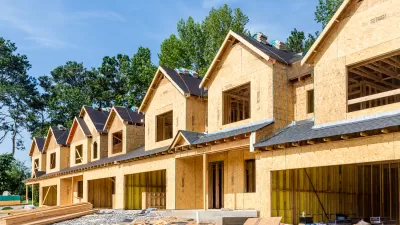Can we green our streets and still preserve urbanism? Seattle and Portland may show us the way.
We're making great progress greening our buildings. "Why not extend the green concepts to our streets as well?" Thus asks New Urbanist planner Mary Vogel, a leader in the design and deployment of High Performance Urban Structure. "Why not have landscaping that works to treat stormwater and recharge groundwater, and that adds habitat for native pollinators, biodiversity to the landscape, and beauty to the environment?"
Because of a challenge from CNU founder and Gentilly Charrette leader, Andres Duany, while we were working together with him here in New Orleans, Vogel goes even further. "Why not provide these elements in the densest parts of new and old urban areas? Could not multifunctional landscaping work as well in a place with a streetscape as charming as that in Old Town Alexandria or the French Quarter?"
She found that Seattle and Portland, Oregon are leading the way. They are redefining streets to be a critical part of the public realm rather than just thoroughfares for cars. And they are using the streetscape to make stormwater runoff a thing of the past. They are beginning to "green" streets even in their most populous areas.
Vogel believes that Seattle and Portland have come closest to designing natural stormwater management for an urban density that would please urbanists of all stripes. "Portland's 12th Avenue is a model for fitting nature-based stormwater management into the traditional street network in moderate- to high-density areas. In bringing even more of nature's functions into such areas, Seattle's "Swale on Yale" and Taylor 28 move further in the direction of...high-performance infrastructure. As designers incorporate these ideas in their own designs, expect them to spread -- like native fireweed after a forest fire."
Thanks to Charles Reith
FULL STORY: Moving Toward High Performance Infrastructure [Adobe PDF, 350 KB]

Pennsylvania Mall Conversion Bill Passes House
If passed, the bill would promote the adaptive reuse of defunct commercial buildings.

Planning for Accessibility: Proximity is More Important than Mobility
Accessibility-based planning minimizes the distance that people must travel to reach desired services and activities. Measured this way, increased density can provide more total benefits than increased speeds.

Fair Housing Cannot Take a Back Seat to ‘Build, Baby, Build’
If we overlook fair housing principles in the plan to build US housing back better, we risk ending up right back where we started.

LA Metro Board Approves New 710 Freeway Plan
The newest plan for the 710 corridor claims it will not displace any residents.

Austin’s Proposed EV Charging Rules Regulate Station Locations, Size
City planners say the new rules would ensure an efficient distribution of charging infrastructure across the city and prevent an overconcentration in residential areas.

Making California State Parks More Climate-Resilient
A recently released report offers recommendations for keeping state parks healthy and robust, including acquiring additional land for conservation and recreation.
City of Costa Mesa
Licking County
Barrett Planning Group LLC
HUD's Office of Policy Development and Research
Mpact Transit + Community
HUD's Office of Policy Development and Research
Tufts University, Department of Urban and Environmental Policy & Planning
City of Universal City TX
ULI Northwest Arkansas
Urban Design for Planners 1: Software Tools
This six-course series explores essential urban design concepts using open source software and equips planners with the tools they need to participate fully in the urban design process.
Planning for Universal Design
Learn the tools for implementing Universal Design in planning regulations.























